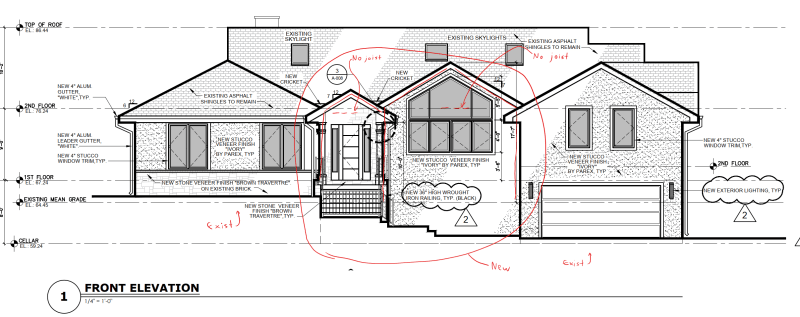I realize I may have come off as an academic with little "real world" experience in my original post on this topic. Nothing could be further from the truth. I started my own practice in 1987 after working for others for 10 years. Originally, my clients were contractors doing residential remodeling. Thank GOD I didn't keep a time card then! I had to shave every nail and foot of shear wall out of all of my designs to keep my customers. I eventually got into commercial work, hired a staff and realized that I wasn't happy managing people and creating a workflow geared for the "lowest common denominator". I eventually let every one go and returned to my roots. For about the last 15 years, I've returned to residential remodeling. I've been very fortunate to find a niche in the high end market of Southern California where I could produce work I am proud of. I have NO IDEA how many structures I've designed in my career. LOTS!
A very common project I have is to remove the flat ceiling of a residence and convert it into a vaulted ceiling. I would add ridge and hip beams below the existing ridge/hip boards, and add an inverted HSS chevron where the hips meet the ridge. About a year ago, I got a license for RISA 3D. I always wondered about deflections in these kinds of structures. So, while I was learning RISA 3D, I built a representative model. I really was surprised by the results. Even when I don't use RISA on a project, I am much more careful about deflections and stiffnesses of members. I believe that's a good, not bad thing. I've gotten efficient enough with RISA, where I can use it productively (i.e., faster than doing it by hand) about every third project.
I am certainly not suggesting that everyone/anyone NEEDS to use 3D software to design a house. That's ludicrous. However, with the exception of simple beams, some kind of analysis software, even 30 year old 2D software, makes it possible to look at deflections. From a 2D analysis, most of us can extrapolate to 3D most of the time. Even the "bowing wall" problem can be solved in 2D. The wall has maximum bow at the midspan of the ridge and has zero bow at the ends. Once that is known, it is pretty easy, either by quantifying or qualifying, to determine the overall impact on the structure, including the secondary stresses in the top plate, regardless if one determines those stresses are from flexure or catenary action. If the wall bows, there are stresses in the top plate...because it gets longer!
Most of us know that a lot of the stuff in the conventional framing provisions don't "calc out". Is that a reason to stick our heads in the sand or at least pause to see if we should do something different, even at the risk of being accused of "over engineering"?
Hopefully, what I've achieved here is to get engineers to think about deformations, particularly with wood structures. If I've offended anyone, it was purely unintentional.


